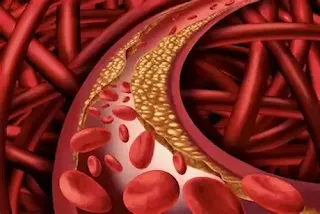Warning Signs of High Cholesterol You Shouldn’t Ignore
 |
| Common physical signs like xanthelasma may hint at high cholesterol levels. Early detection can help prevent heart disease. |
1. Why Cholesterol Matters—and What the Latest Science Says
Cholesterol is essential for building cells and hormones, but elevated LDL (“bad”) cholesterol and other lipid markers can accelerate artery-clogging and cardiovascular disease—even before obvious symptoms emerge. Worldwide, high cholesterol contributes to approximately 4.4 million deaths annually, underscoring its critical health impact .
Recent research from the PROSPECT II substudy reinforces that LDL‑C, non‑HDL‑C, and total cholesterol strongly correlate with the severity of artery plaque—but interestingly, Lp(a) correlates with vulnerable plaque, making it a unique risk marker . Meanwhile, innovative drugs like lepodisiran can nearly eliminate Lp(a), a lifelong inherited risk factor, per early 2025 trial results .
Importantly, the once widely accepted “lower-is-always-better” LDL strategy is being refined. A 2024‑2025 study in individuals with coronary artery disease (CAD) revealed a U‑shaped relationship: both very low (< 50 mg/dL) and high (≥ 130 mg/dL) LDL levels were tied to increased all‑cause mortality . Thus, personalized LDL targets are increasingly recommended.
2. Subtle & Visible Warning Signs You Shouldn’t Miss
High cholesterol often acts as a “silent killer,” with no overt symptoms until dangerous complications emerge . But here are early clues that should prompt a doctor's visit:
- Xanthelasma Palpebrarum: Yellowish fatty deposits on eyelids—commonly seen in familial hypercholesterolemia .
- Corneal Arcus: Gray-white ring around the iris—another sign especially in younger adults .
- Tendon Xanthomas: Hard lumps on joints or Achilles tendon—indicative of genetic lipid disorders .
- Cold, Numb, or Tingly Extremities: Early signs of reduced circulation from plaque buildup (PAD) .
- Poor Wound Healing: Especially in feet—due to impaired blood flow .
- Fatigue, Chest Discomfort, Shortness of Breath: Signs of coronary artery narrowing .
Inherited conditions like familial hypercholesterolemia often display physical symptoms early, enhancing the importance of screening among family members .
3. Groundbreaking Biomarkers: ApoB & Lp(a)
Standard tests measure LDL and HDL cholesterol—but new biomarkers provide deeper insight:
- Apolipoprotein B (ApoB): Each LDL, VLDL, and IDL particle contains one ApoB molecule, making it a precise measure of atherogenic particle count. Studies show normal LDL but high ApoB still raises heart risk, especially in diabetes or obesity .
- Lipoprotein(a) (Lp(a)): Genetic lipid that independently predicts heart attack and stroke. Trials of Lp(a)-reducing lepodisiran show nearly 100% reduction—awaiting outcome data on actual heart event risk .
Many experts now advocate testing ApoB and Lp(a) in patients with metabolic issues or familial risk, to guide personalized treatment plans .
4. New Dietary Findings: Pecans & Eggs
Nutrition science is evolving:
- Pecans as Heart-Healthy Snack: A 12-week US study found that swapping typical snacks for pecans lowered LDL, non-HDL, and triglycerides—and improved Dietary Guidelines adherence by 17%
- Eggs Not the Culprit: A July 2025 study found that two eggs a day in a low‑saturated‑fat diet reduced LDL compared to diets high in saturated fats—challenging outdated cholesterol dogma .
Bottom line: reduce saturated fats (especially tropical oils, processed meats), increase fiber, omega‑3s, nuts, and lean protein for better cholesterol outcomes .
5. Lifestyle & Medical Strategies Backed by Science
✔ Lifestyle First
- Diet: Focus on whole grains, polyunsaturated fats, fruits, vegetables, pecans, salmon, and legumes; reduce saturated fats to <6 advises="" aha="" calories="" daily="" li="" like="" of="">
- Exercise: At least 150 min/week of moderate aerobic activity improves HDL and lowers LDL .
- No Smoking: Smoking reduces HDL and accelerates plaque formation .
- Weight & Stress Management: Both obesity and stress impact lipid metabolism—especially in perimenopausal women .
Medical Therapies
- Statins: First‑line drugs reducing LDL by 40–60%; side effects include mild muscle aches or elevated liver enzymes .
- Ezetimibe: Often used in combination with statins for additional LDL reduction .
- PCSK9 Inhibitors: Advanced monoclonal antibodies or siRNA treatments that can reduce LDL > 50%, safe with close monitoring .
- Lp(a) Therapy: Lepodisiran shows promise (90–100% Lp(a) reduction), though phase 3 trials are still ongoing .
- Personalized Targets: Aim for LDL < 70 mg/dL (or < 55 mg/dL in very high‑risk), while avoiding extremes below 50 mg/dL in CAD patients .
6. Who Should Be Screened & When
Guidelines recommend:
- Children & Teens: Screen once at ages 9–11, then between 17–21—increasingly important for families with early heart disease .
- Adults: Routine checks every 4–6 years, more frequently if high blood pressure, diabetes or family history is present .
- High-Risk Groups: Those with obesity, metabolic symptoms (e.g. perimenopausal), or genetic risk factors should screen more often and consider ApoB/Lp(a) testing .
Take Control Now
High cholesterol doesn’t always announce itself—but early detection via blood tests, awareness of subtle signs, and smart use of biomarkers like ApoB and Lp(a) can empower prevention. With updated science affirming heart-healthy foods (nuts, eggs in moderation), refined cholesterol targets, and evolving therapies, you can shape a personalized strategy to protect your heart now.
Take action today: Get your lipid panel (including ApoB/Lp(a) if at risk), adjust diet and lifestyle, and discuss with your clinician the best individualized LDL goals and possible therapies.
References
- Erlinge D et al., “Lipoprotein(a), Cholesterol, Triglyceride Levels and Vulnerable Coronary Plaques,” PROSPECT II Substudy (JACC, May 26 2025)
- Hart T L et al., “Consuming pecans as a snack improves lipids/lipoproteins…,” Am J Clin Nutr. 2025 Apr;121(4):769‑778
- Penn State Univ., “Replacing other snacks with pecans may improve cholesterol, diet quality” (Mar 17 2025)
- News‑Medical, “A pecan a day keeps bad cholesterol away” (Mar 24 2025)
- Erlinge D et al., “Lipoprotein(a), Cholesterol, Triglyceride Levels, and Vulnerable Coronary Plaques” (JACC 2025;85(21):2011–2024)
- Lp(a) Forum: “ALPACA trial shows sustained Lp(a) reductions with lepodisiran” (ACC Sessions 2025)




Comments
Post a Comment